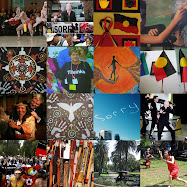
The sandstone overhangs of the Sydney coast and bush provided great shelter for the original inhabitants, the Aboriginal people. There are also a fair few sites where rock carvings are still evident (I don't have any pics at the moment).
Above: Kurnell on Botany Bay.
Below: Nannygoat Hill, Bardwell Valley. This wonderful piece of remnant bushland is only a few kilometres from the centre of Sydney and right near where I live. Walk up Nannygoat Hill here, and here.

About the Aboriginal people of the Sydney region
The original inhabitants of the area shown in Photo 2 were (perhaps) the Gweagal clan of the Dharug Nation. There does seem to be some confusion about this. One source , the National Trust, says that the Gweagal people lived on the southern side of the Cooks River as far as the Georges River, from the shores of Botany Bay inland towards Liverpool. Other sources such as the map linked below, place the Gweagal people on the south side of the Georges River, and the group around Nannygoat Hill is named as the Gameygal.
Anyway, the river provided fish, oysters, crustaceans, waterfowl and the valleys birds, eggs, possums, snakes, wallabies, goannas, wild honey, berries and nuts - in short, an abundant food supply.
Valleys of Wolli Creek and Bardwell Creek contain evidence of Aboriginal presence in smoke-blackened caves. (I took this photo on Nannygoat Hill *, a rocky outcrop amongst a stand of bushland along Wolli Creek). However, it appears that these may have acted as temporary shelters only for hunting parties, as the people lived more permanently along the abundant shores of Botany Bay. Middens have been found along the Bay, and the river, and were one source of lime in the days when lime was burned in order to provide the substance for the bricks and mortar for Sydney buildings.
The northern part of Arncliffe (now a high-rise housing subdivision called Wolli Creek) and some parkland is bordered by the Cook's River, named after - well, yes - Captain James Cook.
You can meet a Gweagal man, Rod Mason, an Aboriginal Discovery Ranger at Botany Bay National Park, at this website of the National Parks and Wildlife Service.
This map of the clans of the Sydney area, definitely places the Gweagal people at Kurnell.




la couleur sur les pierres de la première photo est magnifique.
ReplyDeletethe colour on stones of the first photograph is splendid.
Good images and story, Sally. Did you get any images of the cut away bits out on Cockatoo Island?
ReplyDeleteThe formations are really quite beautiful. Great photos, Sally!
ReplyDeleteThe formations are really quite beautiful. Great photos, Sally!
ReplyDeleteLove that sandstone. I was only thinking the other day it was about time I did the Wolli Creek walk again.
ReplyDeletevery interesting and lovely pics!
ReplyDeleteThe sandstone is so very beautiful. Very similar overhangs near Flagstaff, Az served the native americans well too.
ReplyDelete